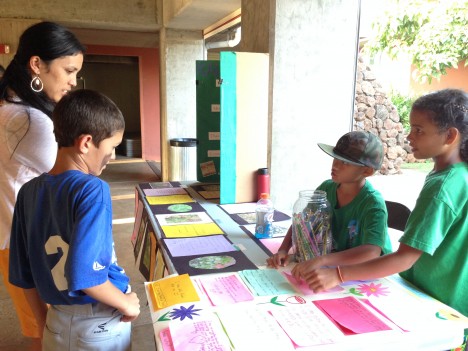No Child Left Inside
Turning litter from Mo’omomi into beautiful art, testing Kalama`ula waters for salinity and soil for pH levels and quizzing curious minds on the Kaunakakai Ahupua`a, students shared their research at the Molokai Digital Bus (MDB) capstone Ho`ike.
Students soaked in science, technology, engineering and math (STEM) research at the fourth annual capstone last Wednesday at Kulana `Oiwi.
About 250 students collected, weighed and sorted data to showcase as part of the MDB Molokai Ho`ike project, a yearlong program that takes students out in the field in a mobile laboratory to experiment. Approximately 75 of those students came to the event to aid their kumu in presenting baseline research to other students, teachers and their ohana.
“It has been really great because I got to see all the other booths, their [testing] areas and other native and invasive species,” said Maunaloa sixth grader Maria Angst. “I even got to see kids younger than me in booths learning about plant species and how to protect them.”
Angst said she is happy to now have gained a better understanding on where she lives.
“I never knew how many invasive species there are on Molokai and now I really want to try to prevent them and bring back all the native species that were here,” she said.
Visiting Pala`au State Park to discover native plants can lead one into the history and culture of the Hawaiian people, Lima said. Molokai Middle School (MMS) students traveled to the area to examine plants and collect samples.
“It inspired me because when I first went out to the site there wasn’t much that I knew about,” said seventh grader Ana Ludgate. “Once I got to learn about [the invasive and native plants] I got more into it and became better at identifying the plants.”
With the Molokai Ho`ike project, 18 teachers aligned curriculum to implement experiments on sustainability through `ahupua`a studies. Kindergarten through fourth grade students, from each elementary school, identified endemic and native flora and fauna. Older students from MMS, ‘O Hina I Ka Malama Hawaiian Language Immersion and 12 students from Molokai High School (MHS) did soil and water analysis for salinity, nitrogen, phosphorus and other unique qualities.
“The teachers and their students wanted to do something hands-on and active so that people would be able to experience what they did throughout the year,” said U`ilani Lima, site coordinator for the MDB. “The students are able to be leaders, teachers and also go around learning from other research.”
The MDB, launched in 2010, exposes local students to STEM career paths through projects and Hawaiian culture-based research. Since its launch in 2004, the Hawaii Source Education Outreach program, also known as the Digital Bus, has introduced 9,000 K-12 students and counting on Maui and Molokai to the wonders of hands-on experiments in their own backyards.
The MDB is funded through the Alaka`ina Foundation, which develops future generation of leaders, especially those in rural areas, through educational initiatives, and the National Oceanic and Atmospheric Association’s Bay Watershed Education and Training program. The Digital Bus will extend to other classes at MHS next year if granted additional funding.
Lima said the MBD builds leadership and ownership for students to address environmental issues happening on island now before it’s too late.
“The more kids we can support with the Digital Bus the better,” Lima said. “If we start them young by the time they get to high school they’ll already be leaders. That is our hope.”













Don't have a Molokai Dispatch ID?
Sign up is easy. Sign up now
You must login to post a comment.
Lost Password